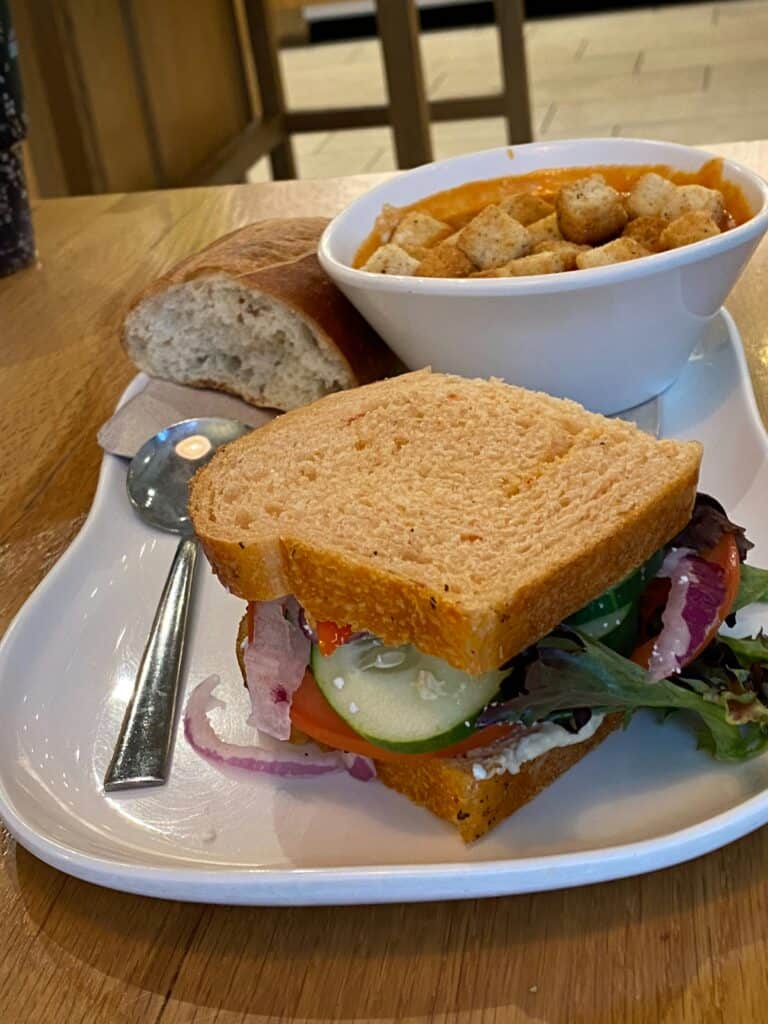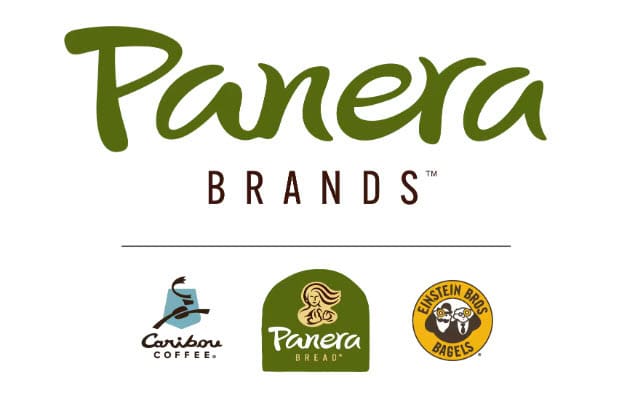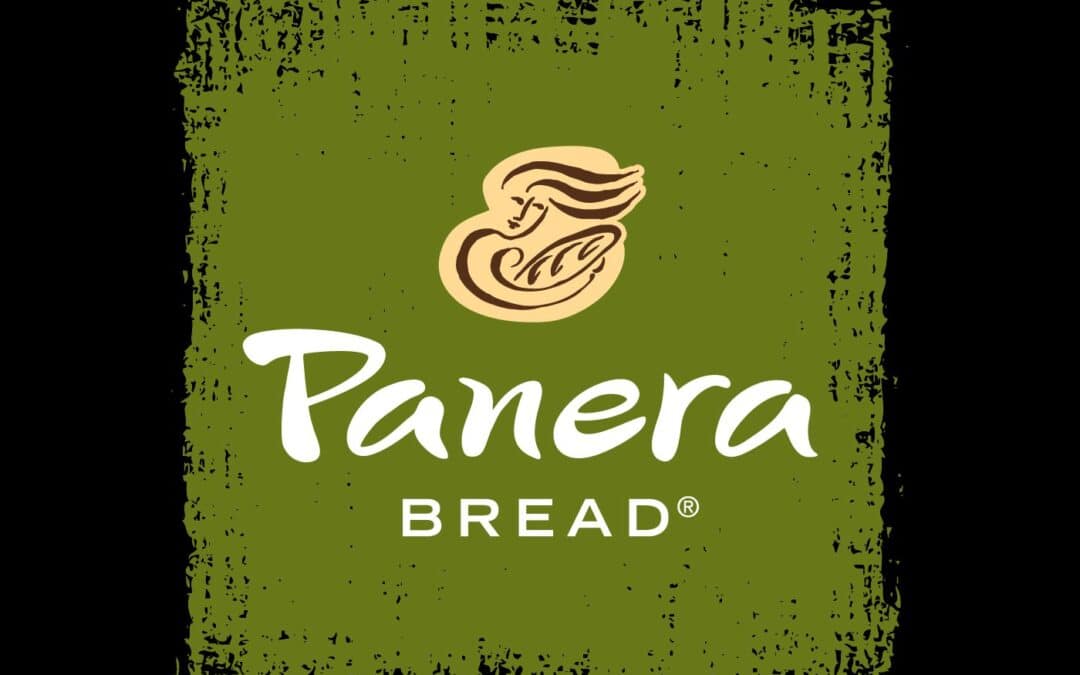When my biweekly cleaning service arrives to clean our house, my son AJ and I go out to lunch to get out of their way.
Panera is among the restaurants in our regular rotation. We have long considered it one of our healthier options. I love soup and salad for lunch. AJ enjoys a turkey sandwich.
Three visits ago, AJ noticed Panera had changed the turkey they serve. He still likes it, but not as much as the former one.
Last time I ordered Panera’s Fuji Apple Chicken Salad, I noticed they’d changed the chicken too. Gone was the seasoned, high-quality sliced chicken. In its place, smaller sliced chicken pieces with a mealier consistency, like I’d expect from a college cafeteria.

Ugh. Another change that lessens Panera’s appeal and takes me further from my heyday with them.
My Office Away From Home
I launched my company in late 1999 and have been working from home since then.
In the early 2000s, the Framingham Panera served as my office away from home.
Lunch cost less than $10. Drinks came with endless refills. The cacophony of other diners provided the perfect backdrop for my writing and creativity.
I arrived early. By noon, long lines formed and tables were hard to find.
During the 2008 recession Panera thrived while other restaurants suffered. Panera changed their plates. They refurbished their restaurants. Long lines continued at lunch time.
Around 2010, Panera opened a store in my home town of Natick. An 8-minute drive instead of 15!
The Natick Panera became my go-to for meeting new connections, in-person coaching sessions, and pitching prospects.
Around 2017 I stopped going to work there. Lunches with friends continued, though we noticed prices rising and portions shrinking.
The pandemic stopped the few regular lunch appointments I had there. Since it abated, I’ve rarely seen a long line or had trouble finding a table.
Panera’s Founding Promise
The Panera brand was born in 1993 when Ron Shaich, co-owner of Au Bon Pain, bought the 19-location St. Louis Bread Co. bakery-café chain in Missouri and renamed it Panera Bread. Panera means “bread basket” in Latin.
Shaich’s vision for Panera came from his consumer insights:
“It was very clear to me that about one in three fast-food consumers didn’t feel respected. They wanted real food in an environment that engaged them. They wanted to interact with people who cared. And they were willing to pay more for respect and foods that elevated them, not diminished them.”
Shaich (pronounced “shake”) sold Au Bon Pain in 1999 to focus on building Panera. And build he did.
Focusing on food quality (like antibiotic-free chicken), innovative menu items, infrastructure, and free wifi, Panera opened a new store every few days. By 2006, the chain had over 1,000 locations.
Revenue grew from $151 million in 2000 to $829 million in 2006. Panera went public with a stock offering in 2001.
Thriving During the 2008 Recession and Beyond
When the recession hit in 2008, Shaich saw an opportunity to increase Panera’s competitive advantage and invested big-time in the brand.
In addition to the new plates I noticed, Panera launched low-fat smoothies and new signature dishes. The company revised its salad line, launched new dressings, and moved to grow their own lettuce. Their salad business grew 30% during the recession.

Photo by American Jael on Unsplash
Panera increased their labor force, gave raises, and paid bonuses.
They refurbished stores and built new ones, taking advantage of lower construction costs which were down 20%.
Shaich explained his impetus to spend more while his competitors were cutting back:
“I believe the biggest detriment to other companies is intense overreaction. There is intense pressure for short-term results. I compete for two, five, 10 years out, but if you’re competing for the next two quarters I have a lot more options than you do.”
In 2010, when the brand was 17 years old, the company initiated several new programs to deepen its niche and reassert its fast-casual restaurant category leadership.
In my book Teenage Wastebrand, I call the impetus to reassert your niche leadership during your brand’s adolescence “Defending Your Varsity Spot.” Shaich’s focus on competitive advantage meant Panera did not wait for a crisis to act. Savvy move!
Investments in technology gave diners digital access, enabling orders via in-store kiosks and online. The MyPanera loyalty program and the 100% clean food commitment, including its “No No List” of prohibited additives, further set Panera apart.
By 2017, the MyPanera program had 28 million members. Digital sales hit $1.2 billion. Over 20 years, Panera stock outperformed its restaurant competitors and delivered 25%+ annual returns.
Panera Gets JABbed
JAB Holding Co., a private equity firm, acquired Panera in July 2017, ending Panera’s successful 26-year run as a public company.
Two years later in an interview with Boston Magazine, Shaich shared the reason he sold Panera. He said:
“I was profoundly worried. What I saw is that increasingly, our public capital markets have become short term…it’s putting increasing short-term pressure on our public-company boards and CEOs. The manifestation of it is the theory that the only role of a public company’s CEO is driving up the share price in the short term—to hell with employees and the communities you operate in.”
When the acquisition was announced in April 2017, Ron Shaich said he planned to stay as CEO. “They’ll have to carry me out with my boots on,” he told The Associated Press.
But in November 2017, Shaich stepped down as CEO, staying on as Chairman. He said it was “the right time for me to step down as CEO while still staying involved in the business.”
I suspect Shaich realized JAB’s goals were to milk the Panera brand for value and resell it in another initial public offering (IPO). They did not share his long-term, customer-focused philosophy and approach.
Indeed in 2021 JAB bundled Panera with two of their long-standing holdings, Einstein Brothers Bagels and Caribou Coffee, under the umbrella Panera Brands and announced an IPO.

Market conditions caused JAB to pull back on the IPO in June 2022, and announce they were preparing again in May 2023. The Financial Times reported on November 30, 2023 that Panera Brands had confidentially filed papers for an IPO.
IPO Prep Cost Cutting Reneges on Panera Brand Promise
To prepare for the IPO, JAB looked to reduce costs to maximize profit and make the stock attractive upon launch.
In November 2023, Panera cut its corporate staff by 17 percent.
In March 2024, Reuters reported learning from internal documents that Panera was quietly removing signage that had “No antibiotics ever,” “Vegetarian fed,” “Grassfed Pasture Raised,” “Animal Welfare,” and any “Hormone” references.
This move was in tandem with relaxing their standards on chicken, pork, turkey, and beef to keep their sourcing costs down.
The sourcing changes would save $21 million.
Reuters also noted that 3 additives had been removed from Panera’s “No No List.”
Per Reuters, Panera’s polling research said they had a competitive advantage in associations with healthiness and responsibly sourced ingredients.
A presentation to executives advocated for the sourcing changes, but advised against ”further modifications to stances on chicken and pork confinement that would save another $8 million but pose a larger brand risk and would put us in a non-competitive position with our policies.”
Did they think we wouldn’t notice? I’m not the only one noting the chicken issue.
As of this writing (July 2024), Panera’s food beliefs on their website still tout antibiotic-free chicken.
In April 2024, Panera introduced a new menu which eliminated 47 items, including beloved items like flatbread pizza, chocolate chip bagels, Napa Almond Chicken Salad sandwich, and autumn squash soup (one of my faves).
Customers have been griping for months online about the brand’s decline, rising prices, shrinking portions, and menu reduction. One customer said on Reddit:
“Panera has gotten far, far away from what it was. Eliminating bakers and…going to pre-made frozen bread…People would come in for the fresh baked bread and soon what they will be getting will be no different than if they went to Walmart and bought frozen dough and cooked it at home.”
Matt Epstein’s video “What happened to Panera?!” showcases the brand’s downfall and went viral on Tiktok, garnering 12,700 comments.
Customer dissatisfaction is so widespread that the press has reported on it and has questioned Panera’s future.
Learn from Panera’s Missteps
While we can’t predict Panera’s future or know how their IPO will go, it is clear JAB’s actions have alienated and lost many customers.
Don’t let this happen to your brand. Specifically:
Don’t gamble with your brand. Ron Shaich built Panera into a fast-casual category leader and high performer by respecting customers and delivering “real food in an environment that engaged them.”
JAB gambled that Panera’s reputation for healthfulness and responsibly-sourced ingredients would mask cost-cutting moves that loosened the clean food pillars the brand was built on. They lost. Stay true to your brand’s promise.
Don’t try to deceive customers. Panera’s success rode on Shaich’s customer respect and astute insights. JAB’s cost-cutting pressure led Panera to shrink portions, increase prices, and renege on several clean food promises. Customers felt duped and departed.
Don’t disregard your employees’ stake in your brand. Panera employees took pride in the crafting and delivery of the food. Dismantling the brand’s artisanal practices and diminishing the quality disheartened them.
It’s not surprising that internal communications documenting compromised standards leaked. Employees may have acted to protect the brand.
Your employees deliver your brand experience. Compromising standards internally means a compromised customer experience.
Don’t do things you don’t want the public to know. Information has a way of finding its way to the internet. Transparency builds trust. Disclosures indicating you are trying to dupe your customers skewer that trust in record time.
Resist the lure of private equity. Unless you have the rare exception of a firm like Elliot Advisors who is investing in Barnes & Noble for the long-term, you are likely to find private equity investors demanding extreme cost cuts to launch an IPO as soon as possible. Brands needs to be nourished, not milked, to grow long-term.
It breaks my heart to see Panera sink like this.
You might think it would break Ron Shaich’s heart too. It might, but he is busy building brands including Tatte, Life Alive, and Cava through his investment firm Act 3 Holdings.
Maybe AJ and I will try one of those next time our cleaning crew arrives.
***
Just for Fun
Watch toy company president Irwin Mainway (Dan Aykroyd) defend his company’s questionable products like Bag O’Glass while showing how traditional toys like a Nerf ball can endanger kids. (4 minutes, 50 seconds)
Enjoy!


HI Evelyn. We haven’t been in touch for a while but I still read your newsletter regularly. In 2011 I was diagnosed with celiac disease and must eat gluten free. I was very disappointed that Panera offered virtually nothing that I could eat, and I stopped going there. A few years back I heard a story which I believe took place at a local Panera, in the Natick area. A mother ordered a grilled cheese sandwich for her daughter online, and put in the note that her child had a peanut allergy. Whoever read that interpreted it by putting peanut butter on the grilled cheese sandwich, and the child wound up in the hospital. So Panera is definitely forever off my list!
Hi Linda. Thanks for your note and letting me know you still read my newsletter! Great to know. I can understand your disappointment with the lack of gluten-free items at Panera. As for the story, I’d be wary of tales far-removed from the source. They have a way of morphing like the game of telephone. I’m not saying I know whether your story is true or not, but peanut butter on a grilled cheese sandwich does raise an eyebrow.
This piece really resonated with me, Evelyn. Recently, my husband and I went to Panera to grab a bite for lunch. We looked at the menu, saw nothing that sounded or looked appetizing, and left. We have noticed the decline in Panera’s food and commitment to its original mission. Amazing how a brand with so much promise can decline so steeply from what made it great to begin with, all for the sake of, for lack of a better word, greed.
Thanks so much for letting me know, Jeannie. Sorry to hear you could no longer find a menu item that looked appetizing at Panera. I am hearing from many people who have noticed their decline. The decline is sad, and underscores how important it is for the culture to hold on to the brand’s promise and values once the founder leaves.